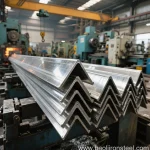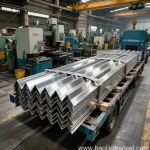In the complex world of industrial commodities, few materials tell as compelling a story as steel. Today’s market sees basic carbon steel prices ranging from $0.60 to $1.20 per pound, while specialized grades like stainless steel command premium prices of up to $5.00 per pound. However, these figures merely scratch the surface of a deeply intricate global market ecosystem.

The Foundation of Modern Industry
Steel remains the backbone of modern civilization, playing a crucial role in everything from skyscrapers to smartphones. Its pricing mechanism reflects this fundamental importance, acting as a barometer for global economic health. The journey from iron ore to finished steel products involves numerous factors that influence its final cost per pound.
Manufacturing Costs and Regional Variations
One of the most fascinating aspects of steel pricing is its regional variation. Chinese steel mills, operating with different labor costs and environmental regulations, can produce steel at prices that differ significantly from their American or European counterparts. These regional differences create a complex web of international trade relationships and price arbitrage opportunities.
The Technology Factor
Modern steelmaking has evolved far beyond the basic Bessemer process of the 19th century. Today’s steel mills employ sophisticated technology for everything from basic oxygen furnaces to electric arc furnaces. These technological advancements have a dual impact on pricing: while they require significant capital investment, they also improve efficiency and potentially reduce per-unit costs.
Environmental Considerations and Green Steel
The growing emphasis on environmental sustainability has introduced new variables into steel pricing. “Green steel” production, using hydrogen instead of coal or incorporating recycled materials, often commands a premium but may become the new standard as environmental regulations tighten globally. This shift represents one of the most significant changes in steel pricing dynamics in recent decades.
Market Volatility and External Factors
Steel prices exhibit remarkable sensitivity to external factors:
- Energy Costs: The energy-intensive nature of steel production means that fluctuations in energy prices directly impact steel costs.
- Raw Material Availability: Iron ore and coking coal prices significantly influence steel production costs.
- Geopolitical Events: Trade policies, tariffs, and international relations can cause rapid price swings.
- Transportation Costs: The global nature of the steel trade makes shipping costs a crucial factor in final pricing.
Industry-Specific Demand
Different sectors influence steel prices in unique ways:
Construction Industry: The construction sector’s cyclical nature creates predictable demand patterns, though these can be disrupted by economic conditions.
Automotive Sector: The automotive industry’s evolution, particularly the shift toward electric vehicles, is reshaping steel demand patterns.
Infrastructure Development: Government infrastructure projects can significantly impact regional and global steel prices.
Future Trends and Predictions
The steel industry stands at a crossroads of tradition and innovation. Several factors are likely to influence future pricing:
- Technological Innovation: New production methods and automation may reduce costs but require significant initial investment.
- Environmental Regulations: Stricter environmental standards could increase production costs but may also spur innovation.
- Market Consolidation: Industry consolidation could lead to more stable pricing structures.
- Alternative Materials: Competition from alternative materials like aluminum and carbon fiber affects steel’s market position and pricing.
Investment Implications
For investors, understanding steel pricing is crucial for several reasons:
- Stock Market Impact: Steel prices affect not just steel producers but also companies throughout the supply chain.
- Economic Indicators: Steel price trends often predict broader economic movements.
- Commodity Trading: Steel futures and related financial instruments offer sophisticated investment opportunities.
The Role of Recycling
Steel’s recyclability adds another dimension to pricing. The growing importance of scrap steel in production creates a secondary market that influences overall pricing structures. This circular economy aspect is becoming increasingly significant as sustainability concerns grow.
Looking Ahead
The future of steel pricing will likely be shaped by several key trends:
- Increased digitalization in production and trading
- Growing emphasis on sustainable production methods
- Evolving global trade relationships
- Changes in urban development patterns
- Technological advancements in manufacturing
Understanding steel prices requires considering these multiple layers of complexity. While the basic per-pound price might seem straightforward, it represents the culmination of numerous global factors, technological developments, and market forces. As the industry continues to evolve, staying informed about these various influences becomes increasingly important for anyone involved in the steel market.








